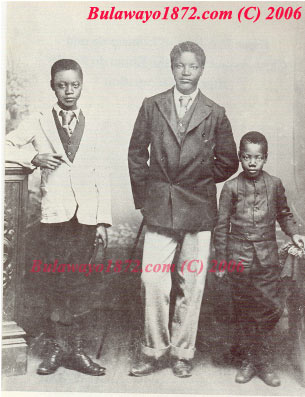|
|
| The
royal Khumalo family of the Matabele: RS Roberts |
|
|
The relatives of Lobengula Khumalo and close associates of the
royal Khumalo Family after the British White Occupation of
Zimbabwe have hardly been covered in historic
documentation. With descriptions of Lobengula last royal
sons (Sidojiwa, Mpezeni, Njube and Nguboyenja), to his
cousins and the Khumalo family praise singer, this article
sheds light in that area.
|
|
|
There is little information about the royal Khumalo family
before or after the Occupation of Zimbabwe by the white
settlers. Consequently there is limited documented
information about Lobengula's children and his relatives.
We give an overview of some of the relatives of the
Khumalo at the time of the occupation and after.
|
MPEZENI
LOBENGULA aka Mpezeni Khumalo
Mpezeni was born in
Bulawayo in about 1880, the second of the four 'royal'
sons of Lobengula who
survived into the white settler Occupation period. His
mother was Lomalongwe, according to Ntabeni Khumalo, she
was the most important wife after Lozigeyi and
consequently Mpezeni
might have been chosen to succeed his father Lobengula.
Ginyilitshe, the royal Khumalo family praise-singer in
the twentieth century, differed in this view though of
the likely successor. Of all Lobengula's sons, Mpezeni
was considered to the best of the bunch. As with Njube
and Nguboyenja, the real importance of Mpezeni
was that he was of the age to be taken by
Cecil J Rhodes to Cape Town for education in 1894.
Read more about Mpezeni Lobengula Khumalo's life here
|
|
|
|
|
SIDOJIWA LOBENGULA a.k.a
Sidojiwa Khumalo
Sidojiwa was born at Nsindeni in about 1888, the youngest of the four 'royal' sons of Lobengula who survived into the Occupation
period. His mother was Ngotsha, a sister of Lozigeyi
Dhlodhlo, she was presumably one of the younger wives as she lived on as a
pensioner until 1955. A young Shona slave who had charge
of Sidojiwa at the time of the war of 1893-4 gave his reminiscences some sixty years later and claimed that the two youngsters tried to get to Gazaland on foot but Sidojiwa's age does not seem to fit with the story, which is rather muddled chronologically
anyway.
Being that much younger than Nguboyenja, Sidojiwa was not sent to Cape Town after his father's death and he probably lived in the Insiza District with his mother under the control of a guardian, former induna Masongo, who married his mother.
Read more about Sidojiwa Lobengula Khumalo's life here. |
 |
MAKWELAMBILA AND JOYI
These men were brothers of Lobengula. Makwelambila was said to be the youngest son of
Mzilikazi but there
is doubt on the authenticity of this. It is said
he was as old as 108, when he died on 12 August
1943, for this would have made him a grown man in the
1870 when Nyanda, also son of Mzilikazi was only a
youngster. Makwelambila became a firm Christian a few years before his
death. Joyi was active in Nyamanda's various manoeuvres and it is possible that he was cousin to
Nyamanda rather than his uncle (that is, a son of one of Lobengula's brothers).
MHWABA AND MADHLOLI
These men were sons of Lobila, brother of
Lobengula. Madhloli was Nyamanda's closest associate and it was he, accompanied by Ntando, who took the Khumalos' second petition to Cape Town and saw the High Commissioner in 1920.
|
|
SIKONKWANA Khumalo
He is referred to as a son of Bayane, brother of Mhwaba and
Madhloli, but also as a son of Zabingane (Qalingana), a son of Mzilikazi and Lomokazi (sister of Mbigo), later a Headman under Chief
Maladaniso. In 1909 he had been deputed by the Khumalos to visit Njube in
Grahamstown. He died in 1936 |
|
GULA Khumalo
He was a son of Bozongwana Khumalo who was brother of
Mlugulu and who had been keeper of Mzilikazi's grave. Gula later became Treasurer of the Matabeleland Home Society. In 1942 he was referred to as a Native Messenger of influence among the Ndebele.
MAHUBASA
He has not been indentified yet, but presumably he was the
Hawubasa who joined Nyamanda's deputation about land in 1920, and, as Hawubasa ka Kumalo, told the story of 'The first visit of the Mandebele to Rhodesia'.
In 1937 he was described as one of the three elders of the Ndebele. |
|
|
SIMON MHLATUZANA, NTANDO KA TEBE
His father buried Mzilikazi, and was the herald sent by Lobengula to Mbigo to call the Zwangendaba to submit in
1870. One of his daughters, that is Simon's sister, Moro, became one of Lobengula's
wives. Simon became a Methodist at some stage and was sent to the Nengubo
Training Institution (Waddilove) in 1910 where he was described as 'very good and reliable'; at the end of his three years training he was sent to the Bulawayo Circuit.
|
|
|
|
|
JULIUS MANJA MPONDO
Manja is generally referred to as a cousin of Lobengula
- but he referred to his father, Somhlolo, as Lobengula's
cousin. Elsewhere he is described as son of Mpondo Khumalo, third in line to the royal
family. He appears to have been born about 1870 and after the Risings, was educated by the Wesleyan
Methodists, like Ntando. After working in Kimberley, he returned to Matabeleland where he became influential in various causes on behalf of the Ndebele, notably the Ilihlo Lomuzi, a movement which later expanded under his initiative into the Matabeleland Home
Society. |
|
| If you feel this is not an
accurate profile and you have a more accurate one, or
you have a clarification , you can submit
your version of the Profile here |
|
| Related
documents: |
| The fall of Lobengula, King of Matebele |
|
|